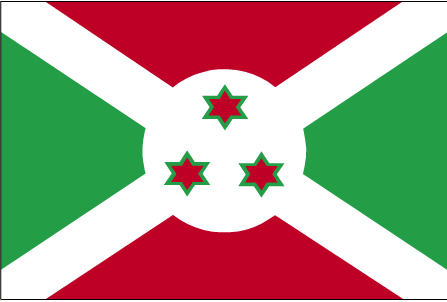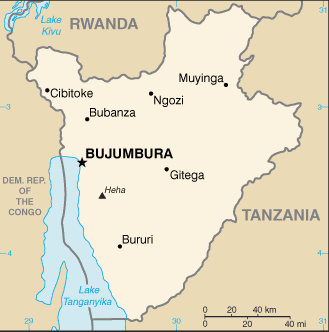
|
|
Advertisements:
EconomyEconomy - overview
Burundi is a landlocked, resource-poor country with an underdeveloped manufacturing sector. The economy is predominantly agricultural. It accounts for just over 30% of GDP and employs more than 90% of the population. Burundi's primary exports are coffee and tea, which account for 90% of foreign exchange earnings, though exports are a relatively small share of GDP. Burundi's export earnings - and its ability to pay for imports - rests primarily on weather conditions and international coffee and tea prices. The Tutsi minority, 14% of the population, dominates the coffee trade. An ethnic-based war that lasted for over a decade resulted in more than 200,000 deaths, forced more than 48,000 refugees into Tanzania, and displaced 140,000 others internally. Only one in two children go to school, and approximately one in 15 adults has HIV/AIDS. Food, medicine, and electricity remain in short supply. Less than 2% of the population has electricity in its homes. Burundi's GDP grew around 4% annually in 2006-11. Political stability and the end of the civil war have improved aid flows and economic activity has increased, but underlying weaknesses - a high poverty rate, poor education rates, a weak legal system, a poor transportation network, overburdened utilities, and low administrative capacity - risk undermining planned economic reforms. The purchasing power of most Burundians has decreased as wage increases have not kept up with inflation. Burundi will remain heavily dependent on aid from bilateral and multilateral donors - foreign aid represents 42% of Burundi's national income, the second highest rate in Sub-Saharan Africa; the delay of funds after a corruption scandal cut off bilateral aid in 2007 reduced government's revenues and its ability to pay salaries. Burundi joined the East African Community, which should boost Burundi's regional trade ties, and received $700 million in debt relief in 2009. Government corruption is also hindering the development of a healthy private sector as companies seek to navigate an environment with ever changing rules. Gdp (purchasing power parity) World Ranking: 163
$5.25 billion (2011 est.)
$5.04 billion (2010 est.) $4.855 billion (2009 est.) Note Data are in 2011 US dollars Gdp (official exchange rate)
$2.356 billion (2011 est.)
Gdp - real growth rate World Ranking: 91
4.2% (2011 est.)
3.8% (2010 est.) 3.5% (2009 est.) Gdp - per capita (ppp) World Ranking: 223
$600 (2011 est.)
$600 (2010 est.) $600 (2009 est.) Note Data are in 2011 US dollars Gdp - composition by sector
Agriculture 31%
Industry 21.4% Services 47.7% (2011 est.) Labor force World Ranking: 88
4.245 million (2007)
Labor force - by occupation
Agriculture 93.6%
Industry 2.3% Services 4.1% (2002 est.) Unemployment rate
NA%
Population below poverty line
68% (2002 est.)
Household income or consumption by percentage share
Lowest 10% 4.1%
Highest 10% 28% (2006) Distribution of family income - gini index World Ranking: 51
42.4 (1998)
Investment (gross fixed) World Ranking: 77
21.2% of GDP (2011 est.)
Budget
Revenues $459.7 million
Expenditures $526.9 million (2011 est.) Taxes and other revenues World Ranking: 165
19.5% of GDP (2011 est.)
Budget surplus (+) or deficit (-) World Ranking: 96
-2.9% of GDP (2011 est.)
Public debt World Ranking: 27
78.4% of GDP
78.7% of GDP Inflation rate (consumer prices) World Ranking: 190
9.7% (2011 est.)
6.4% (2010 est.) Central bank discount rate World Ranking: 29
11.25% (31 December 2010 est.)
10% (31 December 2009 est.) Commercial bank prime lending rate World Ranking: 69
13.33% (31 December 2011 est.)
12.4% (31 December 2010 est.) Stock of narrow money World Ranking: 166
$386.7 million (31 December 2011 est.) $386.9 million (31 December 2010 est.) Stock of broad money World Ranking: 176
$521.8 million (31 December 2011 est.) $628.4 million (31 December 2010 est.) Stock of domestic credit World Ranking: 167
$576.3 million (31 December 2011 est.) $571.3 million (31 December 2010 est.) Market value of publicly traded shares
$NA
Agriculture - products
Coffee, cotton, tea, corn, sorghum, sweet potatoes, bananas, cassava (manioc); beef, milk, hides Industries
Light consumer goods such as blankets, shoes, soap; assembly of imported components; public works construction; food processing Industrial production growth rate World Ranking: 40
7% (2010 est.)
Electricity - production World Ranking: 174
208 million kWh (2008 est.)
Electricity - consumption World Ranking: 170
273.4 million kWh (2008 est.)
Electricity - exports
0 kWh (2009 est.)
Electricity - imports
80 million kWh; note - supplied by the Democratic Republic of the Congo (2008 est.) Oil - production World Ranking: 158
0 bbl/day (2010 est.)
Oil - consumption World Ranking: 181
3,000 bbl/day (2010 est.)
Oil - exports World Ranking: 142
0 bbl/day (2009 est.)
Oil - imports World Ranking: 174
2,450 bbl/day (2009 est.)
Oil - proved reserves World Ranking: 113
0 bbl (1 January 2011 est.)
Natural gas - production World Ranking: 160
0 cu m (2009 est.)
Natural gas - consumption World Ranking: 158
0 cu m (2009 est.)
Natural gas - exports World Ranking: 71
0 cu m (2009 est.)
Natural gas - imports World Ranking: 165
0 cu m (2009 est.)
Natural gas - proved reserves World Ranking: 158
0 cu m (1 January 2011 est.)
Current account balance World Ranking: 89
-$255.4 million (2011 est.)
-$181.5 million (2010 est.) Exports World Ranking: 191
$99.5 million (2011 est.)
$101.9 million (2010 est.) Exports - commodities
Coffee, tea, sugar, cotton, hides Exports - partners
Germany 15.7%, China 10.5%, Sweden 9.5%, Belgium 9%, Pakistan 7.4%, US 7.4%, France 4.3% (2011) Imports World Ranking: 188
$533.3 million (2011 est.)
$440.3 million (2010 est.) Imports - commodities
Capital goods, petroleum products, foodstuffs Imports - partners
Saudi Arabia 16.8%, Belgium 8.2%, China 7.5%, Uganda 7.4%, Kenya 6.5%, Zambia 6.4%, US 6.2%, France 5% (2011) Reserves of foreign exchange and gold World Ranking: 149
$295.5 million (31 December 2011 est.) $332.1 million (31 December 2010 est.) Debt - external World Ranking: 165
$573.4 million (31 December 2011 est.) $533.8 millionExchange rates
Burundi francs (BIF) per US dollar - 1,261.1 (2011 est.)1,230.8 (2010 est.) 1,230.18 (2009) 1,198 (2008) 1,065 (2007) Fiscal year
Calendar year
Comments
Add a new comment: |
Advertisement
Members area
Burundi (Bujumbura):
 
GPS points from Burundi (Bujumbura)
|
||||||||

 Burundi's first democratically elected president was assassinated in October 1993 after only 100 days in office, triggering widespread ethnic violence between Hutu and Tutsi factions. More than 200,000 Burundians perished during the conflict that spanned almost a dozen years. Hundreds of thousands of Burundians were internally displaced or became refugees in neighboring countries. An internationally brokered power-sharing agreement between the Tutsi-dominated government and the Hutu rebels in 2003 paved the way for a transition process that led to an integrated defense force, established a new constitution in 2005, and elected a majority Hutu government in 2005. The government of President Pierre NKURUNZIZA, who was reelected in 2010, continues to face many political and economic challenges.
Burundi's first democratically elected president was assassinated in October 1993 after only 100 days in office, triggering widespread ethnic violence between Hutu and Tutsi factions. More than 200,000 Burundians perished during the conflict that spanned almost a dozen years. Hundreds of thousands of Burundians were internally displaced or became refugees in neighboring countries. An internationally brokered power-sharing agreement between the Tutsi-dominated government and the Hutu rebels in 2003 paved the way for a transition process that led to an integrated defense force, established a new constitution in 2005, and elected a majority Hutu government in 2005. The government of President Pierre NKURUNZIZA, who was reelected in 2010, continues to face many political and economic challenges.